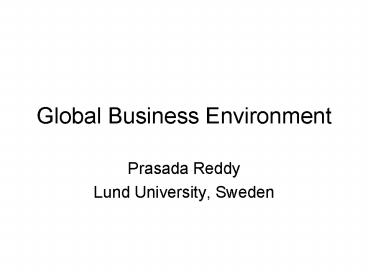Global Business Environment - PowerPoint PPT Presentation
1 / 17
Title:
Global Business Environment
Description:
The art of transferring information from the teacher's notes to student's notes without it entering either ones mind. Business Environment ... – PowerPoint PPT presentation
Number of Views:153
Avg rating:3.0/5.0
Title: Global Business Environment
1
Global Business Environment
- Prasada Reddy
- Lund University, Sweden
2
Lecture - A definition
- The art of transferring information from the
teachers notes to students notes without it
entering either ones mind.
3
Business Environment
- 1) Liberalization of economic policies worldwide
(import-substitution vs. export-led strategies). - 2) Changes in the technology paradigms/regimes.
4
Economic Liberalization 1
- Greater role for private sector.
- Liberalization of trade and investment policies.
- International institutional mechanisms to
reinforce liberalization trends (e.g. WTO, EU,
bilateral agreements) - Sectoral policies affecting innovation (e.g.
Intellectual property rights, clinical trials,
etc.)
5
Economic Liberalization 2
- International standards setting (e.g. ITU, UN)
facilitated flow of goods and services. - Global harmonization of consumer preferences in
some industries.
6
Technological changes 1
- Changes in techno-economic paradigm
- Emergence of new science-based pervasive
technologies - Even old products incorporate new technologies
- Multi-disciplinary inputs for innovations
7
Technological changes 2
- ICT as a driver and facilitator of globalization
- Companies that did incorporate new technologies
faded away - Learning-by-doing approach to Learning-by-training
approach - Vertical disintegration of value chains
- Divisibility of innovation processes
8
(No Transcript)
9
Chip Design Flow Chart
Market Analysis Product Planning
Define Standards
(Upstream) Market Specification
System/Application Level Specification
Behavioral Level Design
?
RTL Level Design
Speed, Quality, Flexibility, Cost
?
IC Design Implementation Flow
EDA Software Support
Gate Level Design
?
Circuit Level Design
?
Physical Level Design
?
Post-Layout Verification
Asias Advantage
Foundry Manufacturing, Packaging and Testing
(Downstream) Process Technology
Advantage of Advanced Countries
Semiconductor Material, Manufacturing Equipment
10
Global competition 1
- Increased competition (more global competition in
domestic markets also) - Greater complexity in competition
- Oligopolistic competition in major industries
- Emergence of innovative small firms in niche areas
11
Global competition 2
- Shorter product life cycles
- Technology becomes the key factor of
competitiveness - Increasing RD costs
- Shortage of ST skills in advanced countries.
- Access to global markets and resources
12
New Competitors
- Entry of emerging economies as huge markets
- Brazil, Russia, India and China (BRIC-group of
countries) as arbitrators of the global economic
developments - MNCs from the emerging economies
- Local availability of ST skills
- Low costs of operations
13
Corporate responses
- Rationalization of corporate structures
- World/regional product mandates
- Global intra-organizational networks
- Global inter-organizational networks (including
with universities)
14
Implications for innovation 1
- Centre-for-global innovations for global markets
centralized in headquarters - Local-for local innovations for local markets
- Locally-linked innovations in each location for
global application - Globally-linked collaboration between different
local units for global innovations (Barlett and
Ghoshal, 1991)
15
Implications for innovation 2
- Modularity and divisibility of innovation process
(specialization within the innovation process) - Globalization of RD (including to emerging
economies) - RD outsourcing
- Emergence of technology markets and research firms
16
Implications for innovation 3
- Outsourcing of RD to emerging economies
(firms/universities) - Emerging Products for Emerging Markets (e.g.
single-chip mobile phones low-cost car Nano) - Standards setting by China
- Entrepreneurship in emerging economies
17
Implications for innovation 4
- University spin-offs
- Regional/national government policies
- Cluster development/science parks
- New sources of financing for innovation
- Importance of intellectual property rights
- Regional agreements and trade barriers































